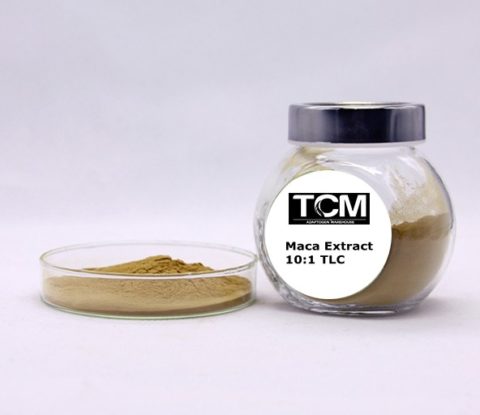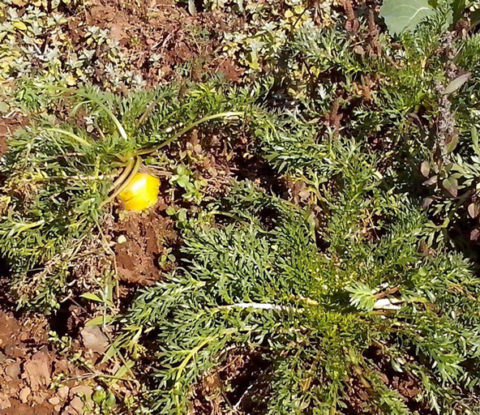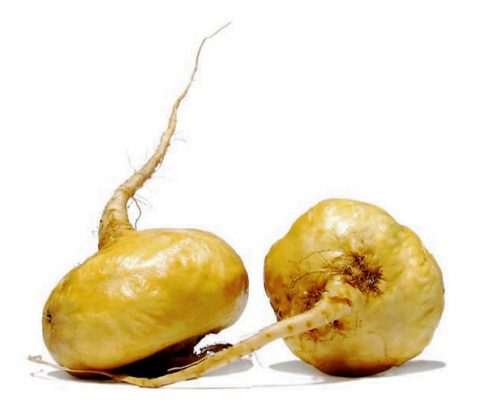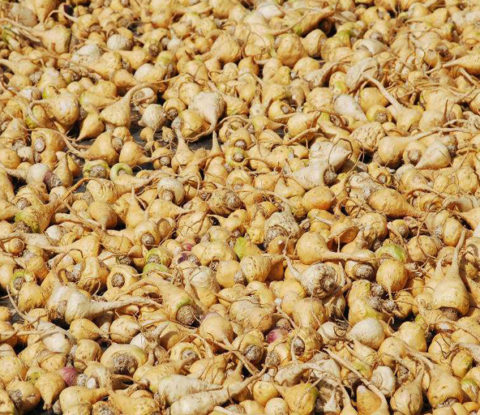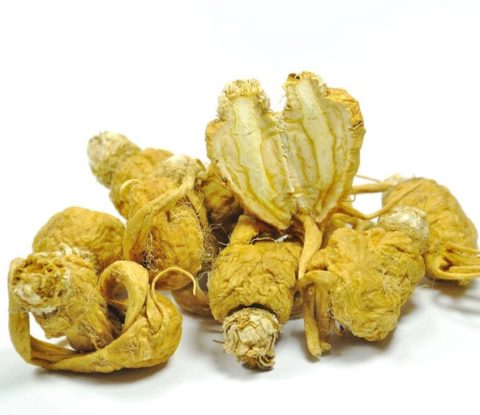
Maca Extract
【English name】: Peruvian Maca Root Extract Powder
【Latin name】: Lepidium meyenii
【Active ingredients】: Beta Ecdysone
【Appearance】: Brownish Yellow Powder
【Origin】: Root
【Specification】: Ratio Extract: 10:1 20:1
【Test Method】: TLC
Brief Introduction
The maca species Lepidium meyenii grows all over several South American countries, but the species Lepidium peruvianum grows only in Peru. Historically, maca has played an important role in the diet and lives of the Peruvian people, where its cultivation goes back perhaps 2 millennia. The plant’s nutritional value helps explain the use of maca as a dietary staple. L peruvianum has been found to be rich in minerals, containing high concentrations of calcium, magnesium, iron, sodium, silica, manganese, copper, zinc, vanadium, and others. It also contains thiamine, riboflavin, ascorbic acid, proteins, carbohydrates, lignans, glucosinolates, phytosterols, and alkaloids.
The alkaloids in its root are believed largely responsible for the plant’s traditional healing use, benefiting the endocrine and reproductive systems by addressing such disorders as chronic fatigue, anemia, and infertility and aiding in enhanced stamina and “female hormone balance.” In addition to the unique mineral content of the central Andes of Peru that leads to L peruvianum’s nutritional content, it appears that the elevation, temperatures, precipitation, and winds of the region make for a special climate and environment that is important in the germination and maturation of this plant because, as I understand it, several growers who have tried to cultivate this species elsewhere in the world have been unsuccessful.
Chemical Composition of Maca Root
Dry Maca hypocotyls contain 59% carbohydrates, 10% proteins (including most of the essential amino acids), 8.5% fiber and 2.2% lipids (Dini et al 1994). They also contain significant levels of iodine (Anonymous 1989), which may explain the Peruvian puna’s absence of the goiter often found in other remote, high-mountain regions of the world. Maca also contains a high concentration of aromatic glucosinolates – benzyl and p-methoxybenzyl glucosinolate in particular- and their derived isothiocyanates (Johns 1981).
These are the same anticance-r compounds found in other cruciferous vegetables like broccoli and cabbage (Wattenberg 1981). Also found in Maca are antioxidant flavanols, including catechin, epicatechin, epicatechin gallate, epigallocatechin, and epigallocatechin gallate (Sandovala 2001). Maca also contains sterols, such as campesterol, stigmasterol and beta-sitosterol (Zheng et al 2000), and alkamide compounds similar to those found in Echinacea spp. (Muhammada et al 2002). Although there is much speculation about which compounds in Maca are responsible for it’s aphrodisiac and fertility-enhancing actions, there is no clear, conclusive evidence regarding this subject.
Traditional Medical Use of Maca Root
The Quechua Indians of Peru’s central highlands consider Maca a highly nutritious food that promotes mental acuity, and physical vitality, endurance, and stamina. It is also well know as an aphrodisiacal tonic that enhances sexual desire and performance, and is especially reputed to increase fertility in male and female humans, as well as domestic animals. Maca is often eaten by Peruvian women who want to get pregnant (Personal communications with Peruvian Maca farmers & dealers 2001, 2003).
Other traditional indications for Maca are anemia, tuberculosis, stomach cancer, memory loss, building strong bones in children, arthritis and rheumatism, respiratory ailments, and alcoholism. It is also valued by Indian women for relief of menopause symptoms. Maca is also given to schoolchildren during exams to assure good test scores (Personal communication with Peruvian Maca farmers & dealers 2001, 2003).
Recently an American herb company (Pure World Botanicals) has received three U.S. Patents on Maca inventions, one as a fertilityenhancing agent. This has displeased many Peruvians who feel their traditional knowledge (i.e., intellectual property) has been stolen from them. Some of these people are now in the process of taking legal action to have this Maca patent withdrawn (Anonymous 2003b).
Traditional and Modern Methods of Preparation
During two Maca expeditions in the central highlands of Peru (2001, 2003) this author has personally observed many Maca products and various ways to prepare Maca foods. The following is a summary of these Maca preparations: “Watia” is the most traditional way to prepare Maca as a food. It is prepared in a crude oven made by digging a hole in the ground and filling it with alternating layers of fresh Maca roots, and hot coals made from champas grass. The hole is then covered with soil and after an hour the roots are well roasted and ready to eat. The roots are then dug up, peeled and eaten. Workers often prepare watia for lunch when they are working in the Maca fields.
Dry Maca roots are made into a viscous, very sweet tea by boiling in water for several hours. This long boiling time is necessary because water boils at only 70º C in the high puna. Dry Maca roots are also prepared as a gruel with milk and this is sometimes the only food eaten by shepherds in distant, isolated areas. Maca is also cooked with chuño (dried potatoes), apples, oats, quinoa or fava beans. Also, dry Maca root flour is mixed (10 to 20% Maca) into bread, cake and cookie recipes, and is also made into puddings and jams. Toasted and ground roots are used to prepare “maca coffee.” Also very popular is traditional “Chica de Maca” which is a mild homemade beer made by fermenting cooked, mashed Maca roots with water. A popular modern way to prepare Maca is as a “liquado” which is the equivalent of the American smoothie. It is prepared by blending boiled Maca roots with water or milk, fruit, honey and cinnamon.
Vendors at the yearly Maca Festival in Junin display many new Maca products that are being developed for the growing international Maca market. On display are such products as Maca marmalade, Maca ice cream, distilled Maca whiskey, Maca wine, and Mace-based cosmetics (Personal observations at the Fifth International Maca Festival 2003). Ironically, Maca capsules and tablets are now being sold in Peruvian pharmacies to modern urbanites who have rediscovered Maca and prefer these more modern, non-traditional dosage forms.
Benefits of Maca Root
1).Energy
An adaptogen is a substance which helps the body adapt to a variety of situations. Some adaptogens, like Ginseng, have an ability to promote energy. Maca is such an adaptogen. As a matter of fact, due to its energizing properties this plant is also referred to as Peruvian Ginseng, although Maca is not in the same family as ginseng. Maca’s nutritional value may contribute to its energizing properties. It is rich in sugars, protein, starches, and essential minerals, especially iodine and iron. The nutritional value of dried Maca root is high, resembling cereal grains such as maize, rice and wheat. It has 59% carbohydrates, 10.2% protein, 8.5% fiber and 2.2% lipids.
It is rich in sterols and has a high mineral content as well. In addition to its rich supply of essential nutrients, Maca contains alkaloids, tannins and saponins. Alkaloids are also present in minute quantity, but have not yet been quantified. Perhaps of greatest significance are the macamides and macaenes which have been standardized at a level of 0.6% by Pure World Botanical, a raw material supplier of Maca to the dietary supplement industry. It may turn out that the macamides and macaenes are the primary active components in Maca. In the July / August 1995 issue of his newsletter, Phil Steinberg’s Cat’s Claw News, Phil Steinberg discussed Maca’s traditional use to increase energy, stamina and endurance. He then commented on his personal experience with Maca: “March of this year I attended the Natural Products Expo West in Anaheim, California. At the show, I was given a sample bottle of Maca to use while I was there. I was amazed at how I was able to work long hours maintaining a high energy level throughout the show. I took approximately 1,000 mg of Maca three times a day along with my usual amount of Cat’s Claw.
The list of achievements attributed to maca is far-reaching. It’s been referred to as Andean ginseng for its ability to boost strength, energy, and vitality. It’s been hailed as an immunostimulant, an anabolic, a hormone balancer, a tonic for intestinal malabsorption, a cure for protein deficiency, a softener of side effects during chemotherapy, an AIDS treatment booster, and a rescue medication during allergy attacks. It’s been shown to have antidepressant activity. In animal studies, it significantly decreases LDL (bad) cholesterol and triglyceride levels, significantly improves glucose tolerance, lowers blood glucose, and increases the activity of free radical scavengers in the liver and blood.
This all may sound like a disjointed and unbelievable mish-mash of unrelated benefits, but that’s the hallmark of a very good adaptogen. Adaptogens are Nature’s greatest gift because they work by promoting the body’s ability to shrug off the imbalances caused by stress. Stress comes in many forms—work pressure, family crises, injuries, surgery, illnesses, menopause—and the resultant disruption in your body’s ability to compensate is at the root of just about every health problem you face as you age. A true adaptogen provides a means by which your body can smile in spite of your stressors. It allows you to return, with shoulders back, to the balanced state of inner strength where natural healing can take place. Maca has been shown to reverse stressinduced ulcers, bring stress-elevated cortisol levels back to normal, and reduce the elevated glucose and weight gain that result from chronic stress. Maca’s proven adaptogenic powers will probably turn out to be the one of the keys to all its health benefits.
2).Fertility & Aphrodisiac
Maca has been used medicinally for centuries to enhance fertility in humans and animals. Soon after the Spanish Conquest in the South America, the Spanish found that their livestock were reproducing poorly in the highlands. The local Indians recommended feeding the animals Maca and so remarkable were the results that Spanish chroniclers gave in-depth reports. Even Colonial records of some 200 years ago indicate that payments of roughly 9 tons of Maca were demanded from one Andean area alone for Hugo Malaspina, M.D., a cardiologist practicing complementary medicine in Lima, Peru, has been using Maca in his practice for ten years Dr. Malaspina first found out about Maca through a group of sexually active older men who were taking the herb with good results. “One man in this group started taking Maca and found he was able to perform satisfactorily in a sexual relationship with a lady friend. Soon everyone in the group began drinking the powdered Maca as a beverage and enjoying the boost that the root was giving their hormonal functions.
I have several of these men as patients, and their improvement prompted me to find out more about Maca and begin recommending it to my other patients.” Chicago physician Gary F. Gordon, former President of the AmericanCollege for Advancement in Medicine, is also a Maca supporter. “We all hear rumors about various products like Maca,” he says. “But using this Peruvian root myself, I personally experienced a significant improvement in erectile tissue response. I call it nature’s answer to Viagra. What I see in Maca is a means of normalizing our steroid hormones like testosterone, progesterone, and estrogen. Therefore it has the facility to forestall the hormonal changes of aging. It acts on men to restore them to a healthy functional status in which they experience a more active libido.”
A chemical analysis conducted in 1981 showed the presence of biologically active aromatic isothiocyanates, especially pmethoxybenzyl isothiocyanate, which have reputed aphrodisiac properties. Initial analysis of Maca indicate that the effects on fertility are a result of the glucosinolates. Today, dried Maca roots are ground to powder and sold in drug stores in capsules as a medicine and food supplement to increase stamina and fertility.
3).Menopause & Menstruation
Traditionally Maca has been used menstrual irregularities & female hormonal imbalances including menopause. As Maca has become increasingly popular, its use has spread to this purpose. Its fertility enhancing properties were supported clinically as early as 1961, when researchers discovered it increased the fertility of rats.
medical practices. In the November, 1988 Townsend Letter for Doctors, physicians commented on the therapeutic uses of Maca. Hugo Malaspina, M.D., a cardiologist practicing complementary medicine in Lima, Peru, has been using Maca in his practice for ten years. He commonly recommends Maca to women experiencing premenstrual discomfort or menopausal symptoms. “There are different medicinal plants that work on the ovaries by stimulating them,” he says. “With Maca though, we should say that it regulates the ovarian function.” Dr. Malaspina further notes that “Maca regulates the organs of internal secretion, such as the pituitary, the adrenal glands, and the pancreas. I have had perhaps two hundred female patients whose perimenopausal and menopausal symptoms are alleviated by taking Maca.”
4).Other Uses
Maca is growing in world popularity due to its energizing effects, fertility enhancement and aphrodisiac qualities. Other traditional uses include, promoting mental clarity, and treating chronic fatigue syndrome. It is used as an alternative to anabolic steroids by bodybuilders due to its richness in sterols. Aguila Calderon, M.D., is the former Dean of the Faculty of Human Medicine at the National University of Federico Villarreal in Lima. He says, “Maca has a lot of easily absorbable calcium, plus magnesium and a fair amount of silica. We are finding it very useful in treating the decalcification of bones in children and adults.” In his practice, Dr. Calderon uses Maca for male impotence, erectile dysfunction, menopausal symptoms, and general fatigue. In Peruvian herbal medicine, Maca is also used as an immunostimulant, for anemia, tuberculosis, menstrual disorders, menopause symptoms, stomach cancer, sterility and other reproductive and sexual disorders as well as to enhance memory.
